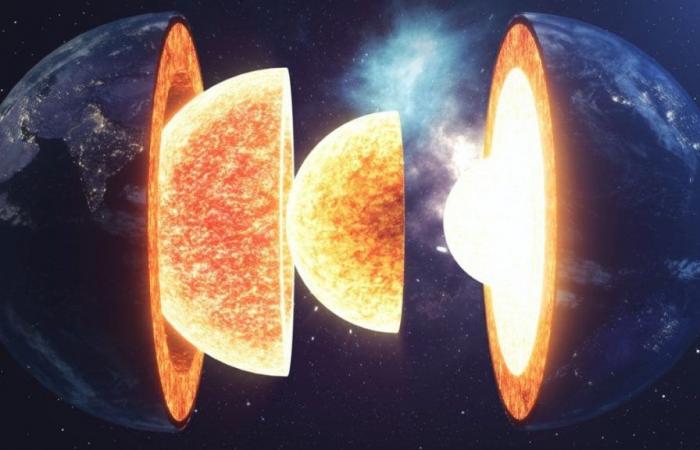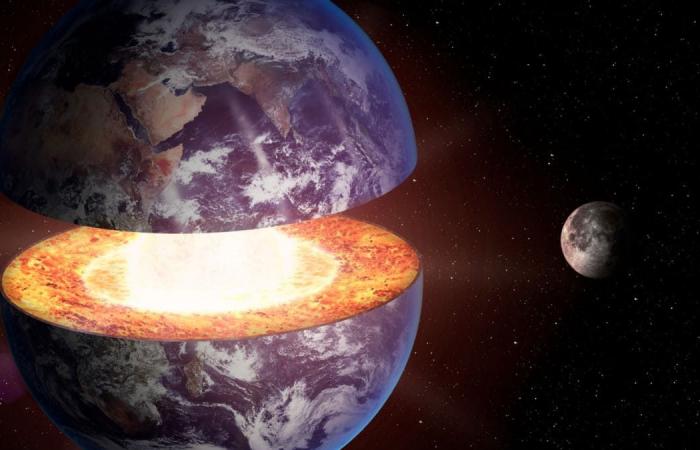New research has brought to light news that may change the cycle of our lives. Earth’s core has experienced a noticeably slower spin over the past 14 years. If this mysterious trend persists, it could result in a prolongation of days on Earthalthough the effects would probably be imperceptible to us.
He Earth’s inner core is a solid mass of iron and nickel about the size of the Moonlocated more than 3,000 miles (4,800 kilometers) beneath our feet. This solid core is surrounded by the outer core, an extremely hot layer of molten metals similar to those in the inner core.
At the same time, The outer core is surrounded by a denser layer of molten rock called the mantle.which in turn is covered by the Earth crust. Although the entire planet is constantly rotating, the inner core can rotate at a slightly different speed than the mantle and crust, due to the viscosity of the outer core.
Earth’s core has been slowing down and is spinning more slowly
Since scientists began mapping the inner layers of the Land through detailed records of seismic activity approximately 40 years ago, the inner core had been spinning slightly faster than the mantle and crust. However, a new A study published June 12 in the journal Nature reveals that since 2010, the inner core has experienced a slowdown and now rotates at a slightly slower rate than the outer layers of our planet.
John Vidale, seismologist at the University of Southern California, Dornsife, said in a statement: “When I saw the seismograms suggesting this change for the first time, I was baffled.. However, upon discovering other two dozen observations pointing to the same pattern, the result became inevitable«.
If the slowdown in the rotation of the inner core continues, its gravitational pull could eventually influence a slight reduction in the speed of rotation of the outer layers of our planetwhich would alter the length of our daysas explained by the researchers.
However, any likely variation would be on the order of milliseconds, which would be “very difficult to perceive“Vidale noted. So it’s unlikely we’d need to adjust our clocks or calendars to accommodate this difference, especially if it were only a temporary change.
Days could be longer on Earth
Scientists have previously raised the possibility that the Earth’s inner core is experiencing a slowdown. This phenomenon, known as “recoil“has been a topic of debate for about a decade, but has been difficult to verify empirically.
In the recent study, researchers examined data from more than 100 repeat earthquakes, seismic events that occur recurrently in the same location, along the atectonic plate boundary in the Sandwich Islands of the Southlocated in the South Atlantic Oceanduring the period from 1991 to 2023.
Each earthquake provided scientists with the opportunity to map the core’s position relative to the mantle. By comparing these measurements, the team was able to observe how the rotation speed of the inner core varied over time. According to Vidale, The new study is the “most convincing” evidence to date that a reversal has occurred.
The researchers wrote that the reason why the inner core is receding is not currently fully understood. However, they suggest it could be caused by “the agitation of the outer core of liquid iron that surrounds it” or “gravitational interactions with the dense regions of the rocky mantle located in the layer.”
The frequency of the recoil is not known for certain. It is possible that the rotation of the inner core experiences periodic accelerations and decelerations, but These changes are likely to unfold over decades or more.. Therefore, larger data sets are required to accurately infer long-term patterns.
The inner core remains one of the most enigmatic layers on Earth. However, recent technological advances are allowing researchers to deepen their knowledge. It has been discovered that The inner core is slightly asymmetrical and softer than expected. Additionally, it appears to wobble slightly off Earth’s axis and contains a separate inner core.
The study authors will continue analyzing seismic data to better understand this fundamental component of our planet and its changes over time. «The movement of the inner core could be even more complex than we imagine“said Vidale.







